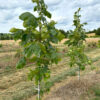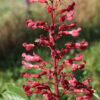This month, we look at yet another member of the red oak (Quercus sect. Lobatæ) group of oak trees, the black oak, Quercus velutina. Black oak is a wide-ranging and adaptable oak, but infrequently used in landscape settings. In the wild, the tree’s native range extends from southeast Minnesota to southern New England and south to east Texas and south Georgia. It is most noticeable as an inhabitant of dry, rocky, upland slopes but also grows well in moister bottomlands. In the wild, mature height ranges from 20-25 m (65-80 ft) in the north to up to 45 m (135 ft) in southern areas.
As is characteristic of the red oak group, Quercus velutina has alternate leaves, 10-20 cm (4-8”) long with 5-7 bristle-tipped lobes divided by broad U-shaped sinuses. The leaves emerge red and covered with fine hairs (hence the specific epithet velutina, ‘velvety’ or ‘fleecy’), becoming first pale greenish-yellow then medium green at maturity. The fall color is usually a deep red, with leaves fading to reddish-brown, then brown before falling.
(Scroll down to continue…)
The male catkins emerge with or just before the leaves at the base of the new leaf shoot. The female flowers are borne on short stalks in the axils of the new leaves. The acorns relatively squat with the cup covering 1⁄3 to ½ of the acorn. They mature in the second autumn after flowering. As with most oaks, the acorns are an important food source for deer, squirrels, chipmunks, turkeys, grouse, jays, and other birds. The bark is grey when young becoming almost black with maturity, deeply fissured, and broken into irregular plates. The inner bark is a bright orange-yellow and was used by both Native Americans and European pioneers as a dye called quercitron; the tree was in fact once known as ‘yellow oak’ due to this property. The wood of black oak is used for barrels and flooring and is often sold as ‘red oak’ in the trade.
In the wild, black oak tends to form a broad, irregular crown. It reaches its greatest size in lowland locations in moist but well-drained and slightly acidic soil. Nonetheless as mentioned above, it is one of the best eastern oaks for dry areas and poor soils, even tolerating drought conditions that would stress many other trees. Typical lifespan in the wild is 175-200 years. Like most oaks, it is a host to many moths and butterflies. It provides excellent shade and good fall color. While too large for the average suburban yard, it is an excellent choice for larger spaces, especially when a specimen that can tolerate less than ideal conditions is called for. It is available from White House Natives in 2” to 3” calipers.







